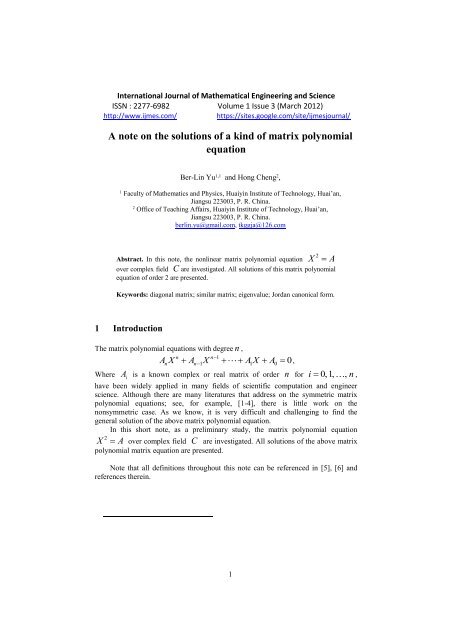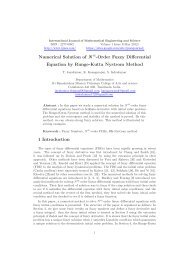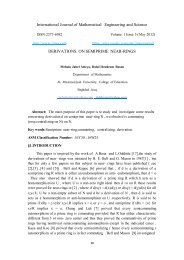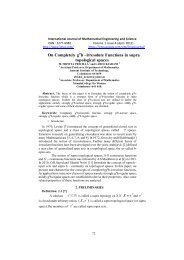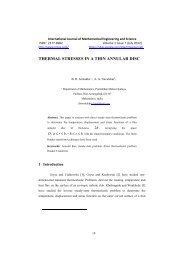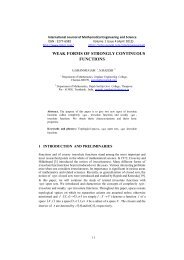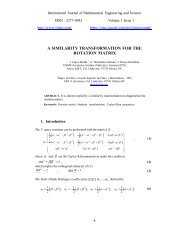A note on the solutions of a kind of matrix polynomial equation - ijmes
A note on the solutions of a kind of matrix polynomial equation - ijmes
A note on the solutions of a kind of matrix polynomial equation - ijmes
Create successful ePaper yourself
Turn your PDF publications into a flip-book with our unique Google optimized e-Paper software.
Internati<strong>on</strong>al Journal <strong>of</strong> Ma<strong>the</strong>matical Engineering and Science<br />
ISSN : 2277-6982 Volume 1 Issue 3 (March 2012)<br />
http://www.<strong>ijmes</strong>.com/<br />
https://sites.google.com/site/<strong>ijmes</strong>journal/<br />
A <str<strong>on</strong>g>note</str<strong>on</strong>g> <strong>on</strong> <strong>the</strong> soluti<strong>on</strong>s <strong>of</strong> a <strong>kind</strong> <strong>of</strong> <strong>matrix</strong> <strong>polynomial</strong><br />
equati<strong>on</strong><br />
Ber-Lin Yu 1,1 and H<strong>on</strong>g Cheng 2 ,<br />
1<br />
Faculty <strong>of</strong> Ma<strong>the</strong>matics and Physics, Huaiyin Institute <strong>of</strong> Technology, Huai’an,<br />
Jiangsu 223003, P. R. China.<br />
2<br />
Office <strong>of</strong> Teaching Affairs, Huaiyin Institute <strong>of</strong> Technology, Huai’an,<br />
Jiangsu 223003, P. R. China.<br />
berlin.yu@gmail.com, tkggja@126.com<br />
A<br />
2<br />
Abstract. In this <str<strong>on</strong>g>note</str<strong>on</strong>g>, <strong>the</strong> n<strong>on</strong>linear <strong>matrix</strong> <strong>polynomial</strong> equati<strong>on</strong><br />
over complex field C are investigated. All soluti<strong>on</strong>s <strong>of</strong> this <strong>matrix</strong> <strong>polynomial</strong><br />
equati<strong>on</strong> <strong>of</strong> order 2 are presented.<br />
Keywords: diag<strong>on</strong>al <strong>matrix</strong>; similar <strong>matrix</strong>; eigenvalue; Jordan can<strong>on</strong>ical form.<br />
X<br />
1 Introducti<strong>on</strong><br />
The <strong>matrix</strong> <strong>polynomial</strong> equati<strong>on</strong>s with degree n ,<br />
Where<br />
i<br />
A X<br />
n<br />
A<br />
n1<br />
n1X<br />
A1<br />
X A0<br />
<br />
n<br />
,<br />
A is a known complex or real <strong>matrix</strong> <strong>of</strong> order n for<br />
0<br />
i 0,1,<br />
,<br />
n<br />
,<br />
have been widely applied in many fields <strong>of</strong> scientific computati<strong>on</strong> and engineer<br />
science. Although <strong>the</strong>re are many literatures that address <strong>on</strong> <strong>the</strong> symmetric <strong>matrix</strong><br />
<strong>polynomial</strong> equati<strong>on</strong>s; see, for example, [1-4], <strong>the</strong>re is little work <strong>on</strong> <strong>the</strong><br />
n<strong>on</strong>symmetric case. As we know, it is very difficult and challenging to find <strong>the</strong><br />
general soluti<strong>on</strong> <strong>of</strong> <strong>the</strong> above <strong>matrix</strong> <strong>polynomial</strong> equati<strong>on</strong>.<br />
In this short <str<strong>on</strong>g>note</str<strong>on</strong>g>, as a preliminary study, <strong>the</strong> <strong>matrix</strong> <strong>polynomial</strong> equati<strong>on</strong><br />
X<br />
2<br />
A<br />
over complex field C are investigated. All soluti<strong>on</strong>s <strong>of</strong> <strong>the</strong> above <strong>matrix</strong><br />
<strong>polynomial</strong> <strong>matrix</strong> equati<strong>on</strong> are presented.<br />
Note that all definiti<strong>on</strong>s throughout this <str<strong>on</strong>g>note</str<strong>on</strong>g> can be referenced in [5], [6] and<br />
references <strong>the</strong>rein.<br />
1
Internati<strong>on</strong>al Journal <strong>of</strong> Ma<strong>the</strong>matical Engineering and Science<br />
ISSN : 2277-6982 Volume 1 Issue 3 (March 2012)<br />
http://www.<strong>ijmes</strong>.com/<br />
https://sites.google.com/site/<strong>ijmes</strong>journal/<br />
2 Main results<br />
Our main result is about <strong>the</strong> soluti<strong>on</strong>s <strong>of</strong> <strong>the</strong> <strong>matrix</strong> <strong>polynomial</strong> equati<strong>on</strong><br />
X<br />
2<br />
A<br />
. (1)<br />
Since <strong>matrix</strong> A is <strong>of</strong> order 2, it follows from [1, Theorem 3.1.11] that A must be<br />
<br />
2 1 <br />
similar to <strong>the</strong> diag<strong>on</strong>al <strong>matrix</strong> X ,<br />
2<br />
<br />
2 1 <br />
or its Jordan can<strong>on</strong>ical form X ,<br />
<br />
and are eigenvalues <strong>of</strong> <strong>matrix</strong> A . It is obvious that <strong>the</strong> <strong>matrix</strong><br />
where <br />
1, 2<br />
equati<strong>on</strong>s (1) and<br />
2<br />
( PXP<br />
1 ) A<br />
(2)<br />
have <strong>the</strong> same soluti<strong>on</strong>s, where P is a n<strong>on</strong>singular complex <strong>matrix</strong>. So it suffices to<br />
c<strong>on</strong>sider <strong>the</strong> following two <strong>matrix</strong> <strong>polynomial</strong> equati<strong>on</strong>s’<br />
and<br />
a<br />
<br />
<br />
<br />
<br />
b<br />
X 2 ,<br />
X<br />
2<br />
a<br />
<br />
<br />
1<br />
<br />
a<br />
respectively, where a and b are complex numbers.<br />
The following two <strong>the</strong>orems are our main results.<br />
Theorem 1. There exists at least a soluti<strong>on</strong> <strong>of</strong> <strong>the</strong> <strong>matrix</strong> <strong>polynomial</strong> equati<strong>on</strong><br />
(3). Fur<strong>the</strong>rmore, if a b 0 , <strong>the</strong>n all <strong>the</strong> n<strong>on</strong>zero soluti<strong>on</strong>s <strong>of</strong> equati<strong>on</strong> (3) have<br />
<strong>the</strong> form<br />
<br />
P <br />
<br />
,<br />
0 1<br />
1<br />
P<br />
0<br />
{ a , b<br />
and if <strong>the</strong>re exists at least n<strong>on</strong>zero entry in }, <strong>the</strong>n all <strong>the</strong> soluti<strong>on</strong>s <strong>of</strong> (3) have<br />
<strong>the</strong> form<br />
1<br />
<br />
<br />
<br />
<br />
2<br />
<br />
(3)<br />
(4)<br />
2
Internati<strong>on</strong>al Journal <strong>of</strong> Ma<strong>the</strong>matical Engineering and Science<br />
ISSN : 2277-6982 Volume 1 Issue 3 (March 2012)<br />
http://www.<strong>ijmes</strong>.com/<br />
https://sites.google.com/site/<strong>ijmes</strong>journal/<br />
2<br />
1<br />
2<br />
where a and <br />
2<br />
b .<br />
Theorem 2. There exists at least a soluti<strong>on</strong> <strong>of</strong> <strong>the</strong> <strong>matrix</strong> <strong>polynomial</strong> equati<strong>on</strong> (4)<br />
for a 0 . However, if a 0 , <strong>the</strong>n all <strong>the</strong> soluti<strong>on</strong>s <strong>of</strong> equati<strong>on</strong> (4) have <strong>the</strong> form<br />
where<br />
2<br />
a .<br />
1 <br />
<br />
2 <br />
<br />
<br />
,<br />
3 Pro<strong>of</strong>s <strong>of</strong> main results<br />
Pro<strong>of</strong> <strong>of</strong> Theorem 1. It is clear that <strong>matrix</strong> <strong>polynomial</strong> equati<strong>on</strong> (3) has at least<br />
<strong>on</strong>e soluti<strong>on</strong>. If a b 0 , <strong>the</strong>n we claim that <strong>the</strong> n<strong>on</strong>zero soluti<strong>on</strong> X <strong>of</strong> equati<strong>on</strong><br />
(3) cannot be diag<strong>on</strong>alizable. In fact, <strong>the</strong> n<strong>on</strong>zero soluti<strong>on</strong> X has an eigenvalue 0<br />
for its determinant is zero. If follows that X is similar to<br />
0<br />
<br />
<br />
1<br />
<br />
0<br />
are <strong>of</strong> <strong>the</strong> form<br />
<br />
<br />
<br />
0<br />
1<br />
<br />
0<br />
. Because<br />
is a soluti<strong>on</strong> <strong>of</strong> equati<strong>on</strong> (3), all soluti<strong>on</strong>s <strong>of</strong> <strong>matrix</strong> <strong>polynomial</strong> equati<strong>on</strong> (3)<br />
<strong>matrix</strong> <strong>of</strong> order 2.<br />
For <strong>the</strong> case 0<br />
0 1<br />
1<br />
<br />
P P<br />
, where P is an arbitrary n<strong>on</strong>singular complex<br />
0<br />
a or b 0 , we first claim that <strong>the</strong> soluti<strong>on</strong> X <strong>of</strong> equati<strong>on</strong> (3)<br />
is diag<strong>on</strong>alizable. In fact, if <strong>the</strong> soluti<strong>on</strong> X is not diag<strong>on</strong>alizable, <strong>the</strong>n X must be<br />
1 <br />
similar to <strong>matrix</strong> , where 0 . Then for some n<strong>on</strong>singular <strong>matrix</strong> P ,<br />
<br />
we have<br />
1<br />
1 a<br />
<br />
P P .<br />
b<br />
2 <br />
<br />
<br />
<br />
p1<br />
p2<br />
. For some n<strong>on</strong>singular <strong>matrix</strong><br />
<br />
<br />
P <br />
<br />
2 <br />
p3<br />
p4<br />
<br />
If follows that<br />
1<br />
<br />
<br />
2<br />
is diag<strong>on</strong>alizable; a c<strong>on</strong>tradicti<strong>on</strong>. So X is similar to<br />
, we have<br />
3
Internati<strong>on</strong>al Journal <strong>of</strong> Ma<strong>the</strong>matical Engineering and Science<br />
ISSN : 2277-6982 Volume 1 Issue 3 (March 2012)<br />
http://www.<strong>ijmes</strong>.com/<br />
https://sites.google.com/site/<strong>ijmes</strong>journal/<br />
C<strong>on</strong>sequently,<br />
p<br />
<br />
p<br />
1<br />
3<br />
p2<br />
1<br />
<br />
p<br />
<br />
4 <br />
2<br />
<br />
<br />
1<br />
p<br />
2<br />
1<br />
p<br />
1<br />
3<br />
<br />
<br />
2<br />
<br />
2<br />
p<br />
<br />
p<br />
1<br />
3<br />
p2<br />
<br />
<br />
p4<br />
<br />
2<br />
<br />
2<br />
p2<br />
ap1<br />
<br />
<br />
2<br />
2<br />
p<br />
<br />
4 bp3<br />
1<br />
<br />
a<br />
<br />
<br />
ap2<br />
<br />
<br />
bp4<br />
<br />
.<br />
<br />
<br />
b<br />
It can be verified readily that all soluti<strong>on</strong>s <strong>of</strong> equati<strong>on</strong> (3) are <strong>of</strong> <strong>the</strong> form<br />
where<br />
2<br />
1<br />
2<br />
2<br />
a and b<br />
.<br />
.<br />
1<br />
<br />
<br />
<br />
2<br />
<br />
,<br />
Pro<strong>of</strong> <strong>of</strong> Theorem 2. It suffices to c<strong>on</strong>sider <strong>the</strong> following two cases.<br />
Case 1. a 0 .<br />
In this case, we claim that <strong>the</strong>re exist no soluti<strong>on</strong> in equati<strong>on</strong> (4). By a way <strong>of</strong><br />
c<strong>on</strong>tradicti<strong>on</strong>, let <strong>the</strong> soluti<strong>on</strong> <strong>of</strong> equati<strong>on</strong> (4) be X . Then X 0 and X has 0<br />
as its an eigenvalue.<br />
Subcase 1.1. 0 is an eigenvalue <strong>of</strong> X with algebraical multiplicity 1.<br />
In this case, it follows from [5, Theorem 1.3.9] that X is diag<strong>on</strong>alizable.<br />
0<br />
0 <br />
Without loss <strong>of</strong> generality, let X be similar to . So we get<br />
0<br />
<br />
P<br />
1<br />
0<br />
<br />
0<br />
2<br />
0 0<br />
P <br />
0<br />
for some n<strong>on</strong>singular <strong>matrix</strong> P . It follows that <strong>matrix</strong><br />
1<br />
,<br />
0<br />
0<br />
<br />
0<br />
1<br />
<br />
0<br />
c<strong>on</strong>tradicti<strong>on</strong>.<br />
Subcase 1.2. 0 is an eigenvalue <strong>of</strong> X with algebraical multiplicity 2.<br />
In this case, <strong>the</strong> soluti<strong>on</strong> X must be similar to <strong>matrix</strong><br />
Clearly, it is a c<strong>on</strong>tradicti<strong>on</strong>.<br />
Case 2. a 0 .<br />
2<br />
X<br />
0<br />
<br />
0<br />
0<br />
0<br />
<br />
0<br />
0<br />
1<br />
<br />
0<br />
.<br />
0<br />
<br />
0<br />
is diag<strong>on</strong>alizable; a<br />
1<br />
<br />
0<br />
. C<strong>on</strong>sequently,<br />
4
Internati<strong>on</strong>al Journal <strong>of</strong> Ma<strong>the</strong>matical Engineering and Science<br />
ISSN : 2277-6982 Volume 1 Issue 3 (March 2012)<br />
http://www.<strong>ijmes</strong>.com/<br />
https://sites.google.com/site/<strong>ijmes</strong>journal/<br />
In this case, <strong>the</strong> soluti<strong>on</strong> X <strong>of</strong> equati<strong>on</strong> (4) is not diag<strong>on</strong>alizable. Without loss<br />
<br />
1 <br />
<strong>of</strong> generality, let <strong>the</strong> Jordan can<strong>on</strong>ical form <strong>of</strong> X be . Then for some<br />
n<strong>on</strong>singular <strong>matrix</strong><br />
C<strong>on</strong>sequently,<br />
p<br />
<br />
p<br />
p<br />
P <br />
<br />
p<br />
1<br />
3<br />
1<br />
3<br />
p2<br />
<br />
p4<br />
<br />
p2<br />
<br />
1 <br />
<br />
p4<br />
0 <br />
, we have<br />
2<br />
p<br />
<br />
p<br />
1<br />
3<br />
p2<br />
<br />
<br />
p4<br />
<br />
1<br />
<br />
0<br />
a<br />
<br />
0<br />
<br />
<br />
1<br />
.<br />
<br />
<br />
a<br />
2<br />
2<br />
p<br />
<br />
1<br />
2p1<br />
p2<br />
ap1<br />
p3<br />
ap2<br />
p4<br />
<br />
<br />
<br />
2<br />
2<br />
<br />
<br />
p3<br />
2p3<br />
p<br />
<br />
.<br />
4 ap3<br />
ap4<br />
<br />
2<br />
By computati<strong>on</strong>, we get p<br />
3<br />
0 , a and 2<br />
p1<br />
p4<br />
1<br />
p1<br />
p1<br />
<br />
1 p1<br />
p1<br />
1<br />
X <br />
0 2p1<br />
0 <br />
<br />
0 2<br />
<br />
p1<br />
<br />
<br />
<br />
<br />
2<br />
0 <br />
<br />
. It follows that<br />
Acknowledgments. This research was supported by Sci. \& Tech. Research Project<br />
<strong>of</strong> Huaiyin Institute <strong>of</strong> Technology (HGB1111).<br />
.<br />
References<br />
1. Henri<strong>on</strong>, D., Sebek, M.: Symmetric Matrix Polynomial Equati<strong>on</strong>: Interpolati<strong>on</strong> Results.<br />
Automatica, 34, 7-34 (1998)<br />
2. Jezek, J.: C<strong>on</strong>jugated and symmetric <strong>polynomial</strong> equati<strong>on</strong>s: parts I. Kybernetika, 19(2), 121-<br />
130 (1983)<br />
3. Jezek, J.: C<strong>on</strong>jugated and symmetric <strong>polynomial</strong> equati<strong>on</strong>s: parts II. Kybernetika, 19(3), 196-<br />
21 1 (1983)<br />
4. Jezek, J.: Symmetric <strong>matrix</strong> <strong>polynomial</strong> equati<strong>on</strong>s. Kybernetika, 22 (1), 19—30 (1986)<br />
5. Horn, R. A. , Johns<strong>on</strong>, C. R.: Matrix Analysis. Cambridge University Press, New York (1995)<br />
6. Golub, G. H., Loan, C. F.: Matrix computati<strong>on</strong>s. Posts \& Telecom Press, Beijing (2009)<br />
5


